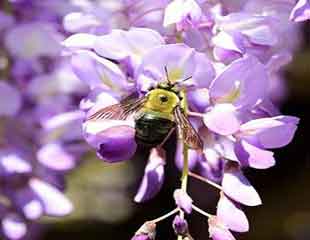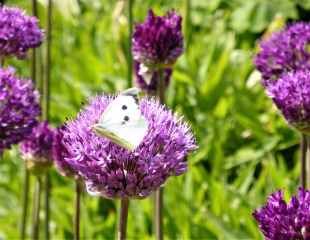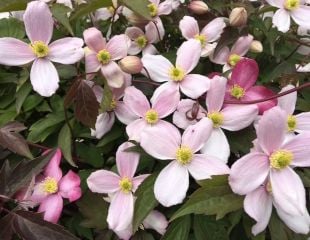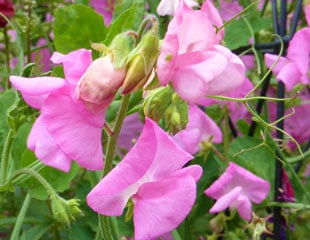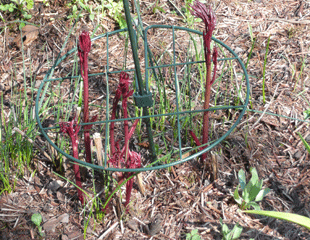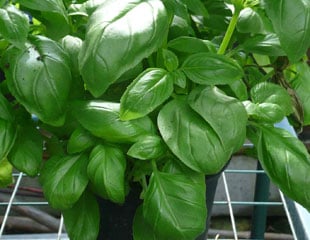What to do in the Garden in May
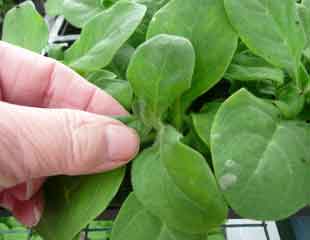
May at a glance top tips
- Get more from your bedding plants, nip out the growing tip to make the plant bush and produce more flowers
- Time to Chelsea chop- not sure how? Watch the video.
- Continue to protect non hardy plants until the end of the month and the risk of frost has passed.
- Check out the Sunday Gardener's list of what to plant in May and what not to plant, just yet.
The gardening magazines may be in full Spring glory, but are the gardens?
Gardening advice has to be adjusted to consider the weather. Each Spring brings different weather from the previous year. May allows gardeners in sheltered parts of the country to put more tender plants outside, but not everywhere. All the country should be frost free by the end of May, but it is always an idea to have a fleece or cloche handy.
May is "Chelsea Chop" time, and it is great for stopping some plants getting too big and leggy, and with others, staggering flowering times. If you haven't used the Chelsea Chop before, read about it the Chelsea Chop
video help How and when to do the Chelsea Chop
Looking for planting inspiration? Plants and Shrubs flowering in May
YouTube videos "What to do in the garden in May" there are 6 short videos in the series covering gardening in May. Each short video covers a gardening topic for May
What to plant and what not to plant in May
Gardeners are keen to get planting but we need to keep an eye on the weather - so what can we plant in May?
Plant outside now
In the veg plot: Broad beans, Runner beans, Peas, Onions, Garlic, Carrots, salad crops, Leeks, Strawberries.
In the garden: all hardy perennials & evergreens. These are plants you may buy from the garden center or online, which are described as hardy. In terms of annuals, you can plant out Sweet peas, and sow hardy annuals where they are to flower (for an explanation of hardy) such as Sunflowers, Cornflowers, Zinnia, Nasturtium, Calendula, Nigella, and Cerinthe major 'Purpurascens'.
Delay planting outside:
Even in May, the weather can still be cold and some plants are best under glass and / or delay planting out at the end of the month or Early June. These are the more tender vegetables which are: French Beans, squashes, Cucumbers, Tomatoes, Melon, Chillies, Aubergine Sweet corn, Courgettes and Sweet peppers.
May is tomato time, buy plants to grow on in the greenhouse, or late in May when all risk of frost has passed tomatoes can be planted out in the veg plot in a sunny spot. Tomatoes need attention to produce a good crop. There is advice on how to grow on the growing Tomatoes pages. There is also a handy Sunday Gardener book " Success with Tomatoes" which contains 55 pages of detailed advice with 23 illustrations everything you need to know about growing tomatoes.
By the very end of May/early June it is safe to plant out tender Bedding plants, and non-hardy plants such as Agapanthus (some), Canna Lilly, Dahlias.
A job for May, whatever the weather, is to stake perennials. I always leave this task too late and end up trying to persuade the delicate stems of a Peony through the hoops of a plant support. Video help.
If you planted Dahlias earlier in the year, the growth takes about 6 weeks to reach to soil surface, which can be around May time, so if there is a frost, it will need to be protected. For advice and tips on growing Dahlias
Growing Sweet Peas
You can plant out sweet peas in April and May because they are half hardy, and will withstand a good degree of cold, as low as - 5 on a night as long as it's not a prolonged spell of frost. It is important to harden off sweet peas before planting out. Sweet peas are good value as they are long flowering and I have picked Sweet peas in late October so you get your money's worth.
Sweet peas like moisture and one tip is to line the trench with newspaper to add extra moisture retention. If sweet peas get too dry, they are prone to mildew.
Someone once asked me why Sweet peas didn't flower for very long and it transpired the gardener had stopped picking them thinking that would preserve the flowers. The reverse is true with Sweet peas. The more you pick, the more you get, so don't stop picking them. For tips on growing sweet peas and for a video about planting out sweet peas. Sweet peas are a red wheelbarrow plant, because they require time and effort throughout the growing season but reward with masses of blooms and scent.
Growing Sweet peas as cut flowers? - tips on how to get straight stems on sweet peas.
The Chelsea Chop
Not like the Barnsley chop. The Chelsea Chop is a way of stopping back herbaceous and perennials plants to make them bushier, with more stems and so more flowers. It's good for plants which get leggy later in the year, such as Nepeta, by chopping it in late May growth will be checked, and the plant will throw out more shoots and flower later. The Chelsea chop is really a light prune, and the result is a more compact plant which will flower slightly later.
Traditionally executed in Late May (about the time of the Chelsea flower ,) the idea is to prune the plant back by about a third, which means reducing the plant stems. You can either chop the whole plant, or selected plants in the group, or individual stems on the plant to stagger flowering. Whilst May is the traditional time, it depends on the growing season as the plant needs to have put on a good growth to be reduced by the Chop.
More information about the Chelsea Chop, a list of suitable plants and a video. I grow Nepeta and later in the growing season Nepeta sprawls all over the place, refuses to be contained by plant supports and lies on adjacent plants. The way to tame it and other plants, which you wish were smaller and neater, is to use the Chelsea Chop; It's very effective. The downside of Chelsea Chop is later flowers, and sometimes smaller.
Caring for Garden plants
May is a good time to feed plants, especially if you are growing plants in containers. You can do this without re-potting by sprinkling the fertiliser on the surface and, with a small hand rake, work it into the top spoil. This is suitable for plants such as Agapanthus, where the container may be full with little bare soil showing.
Alternatively, if there is bare soil and room in the pot, you can "top dress" the container. This means to remove the top few centimetres of compost and replace with new compost with added fertiliser.
Feed garden shrubs and roses now, just add a handful of fertile around the base of shrub and fork it in. If you have time, Roses benefit from at least two feeds per summer.
How to stake perennial plants
Staking plants supports the stems protecting them from damage, especially wind damage. It enables you to train the plant, stopping it from flopping over and keeps it upright so they do not lie over or swamp neighbouring plants. Some of the more vigorous perennials can grow over their neighbouring plants and smother them. It is important to get the stakes in place early because it becomes more difficult to insert the stake as the plant puts on more leaf. If the plant is more mature, it is tricky to get the support in place without damaging plants or the budding flower heads.
Many plants need support, for example Peony, Delphinium, dahlias, Allium, anything waving around in the wind looking vulnerable, or with heavy plant heads, such as Peony, and Oriental Poppies. The choice of support depends on the type of plant, but make sure any ties used are soft and there is room for the plant to grow. In the image above the Peony is at the right stage to stake before it puts on too much growth. Then, train the plant through its support. Different plants need different types of support; Peony do well with a grid support as in the image, Delphinium is better suited to individual stakes and plants such as Crocosmia respond best to firm supports to keep the plant upright, with string or raffia linking the supports. You can make your own plant supports for free.
Shrubs to Prune in May
May is the time you can, if the shrub needs it, prune the early spring flowering shrubs. You should prune these shrubs after flowering; the best time depends on when your shrub finishes flowering, not on published recommendations. Pruning helps to stop the shrub from getting too big for its space and to shape it. If you were admiring a spring flowering shrub, but at the same time thinking it is getting too big, now is the time to attack.
Cut back the older, woodier stems from the base, and if needed you can also cut back, by about half, any long stems. Suitable shrubs are Deutzia, Ribes sanguineum (Flowering current) exochorda x macrantha, Syringa common name lilac, Forsythia, Philadelphus (mock Orange) Spiraea arguta and Viburnum bodnantense. Some of this group may be ready for pruning in May such as the Forsythia, others may need to wait until June.
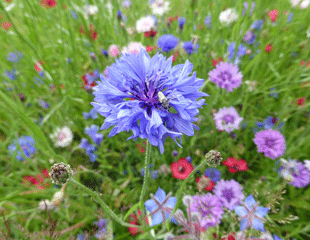
Sowing and planting annuals
There is still plenty of time to sow annuals to add to the colour of the borders and many are easy to grow, such as Calandula, Nasturtium, Nigella, Cornflowers and Sunflowers. The specialist seed catalogues have a fantastic range of seeds and its great fun to grow something unusual.
An excellent annual is morning glory Latin name Ipomoea . A tender annual which is best grown on under glass until at least early June before planting out. An easier annual to grow, which is attractive to bees and butterflies, is our native Cornflower Centaurea cyanus, image above. Its true blue looks stunning on its own or as part of a wild flower patch. Why not grow a collection of annuals and plant a wildflower area This an easy way to create colour and it's much easier that you may think by using a pre seeded mat.
The vexed subject of planting out Bedding plants

Late May is usually a safe time to plant out bedding plants, but don't rush. If it's a cold May, bedding will not like it outside and cold can cause plants to sulk. The plants we buy from garden centres have been grown in perfect conditions, warm, no wind and perfect amounts of water. To bring these plants home and stick them outside in a cold May with a chill wind will give the plants a shock and set back growing. It could delay the plant's growth and flowering for a number of weeks. It is always better to plant bedding plants during a warm spell and get them off to a good start.
Video help When to plant out bedding plants
Even if the plant is fully hardy, it is essential to " harden off" plants grown under glass so they are ready to be planted outside. To do this, put the plants outside on milder days and nights, gradually exposing them to more and more time in the outside conditions. On colder days and nights, bring back under glass or cover with a fleece, gradually reducing the cover until they are out 24/7 and acclimatised to the growing conditions outside. A good tip, if you have a potting shed or greenhouse, is to plant up the containers and grow them on in the greenhouse until late May. The plants will get established in the container and will be more mature when moved outside.
Whether outside or in, nip out the growing points ( see image above,) to produce a bushier plant, otherwise some plants, particularly petunia, fuchsia, verbena will grow leggy. Whether growing bedding plants on inside/windowsills/in the greenhouse, I usually stop them from flowering by pinching out the flowers until ready for planting out. There is no point in the plant using energy to flower in the greenhouse, nip out the flower and divert the energy to the plant's growth until outside in the garden.

Cut back early flowering Perennials
This is the time to cut back the early flowering plants. In May/June, the early perennials such as Aubrieta and Alyssum which have finished flowering and need to be cut back.
If your aubretia looks similar to the one in the images, overgrown with a bald patch, it needs cutting back.
This will promote good flowering next year and encourage the compact shape. Simply trim into neat shape, removing all spent flowers.
Jobs for May in the Veg plot
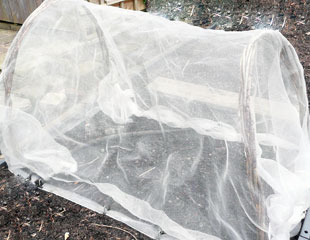
Vegetables to sow in May
Continue to sow under glass the more tender vegetables such as French beans, tomatoes, sweet corn, squashes, Cucumber and courgettes. Keep under glass until frost-free conditions are available in the veg plot, which means late May/early June, depending on where you are in the country and the garden aspect.
If the weather conditions are right and the soil warmed up, you can sow outside the hardier veg such as carrots, broad beans, kale and purple sprouting broccoli. Carrots need protection against carrot fly and this needs to be a physical barrier such as euro mesh, illustrated in the image above. Carrot fly can severely damage the crop, and although it is a nuisance to erect mesh around the carrots, it is the only safe way. Specialist varieties of Carrots such as Flyaway are less vulnerable to damage, but not guaranteed.
Tips on how to grow carrots and a Video on how to plant out beans and Video on how to Grow and plant onions and garlic.
Any tomato plants which are filling their pots and looking at bit top heavy will need to be potted on before being planted in final position/container. More about growing tomatoes and video How (and why) to Pot on tomatoes. Even at this early stage tomatoes will be producing side shoots and it is important to remove these regularly. Advice on side shoots look like and how to remove them on growing tomatoes and video.
"Success with Tomatoes" by the Sunday Gardener, is a comprehensive short book about growing tomatoes.
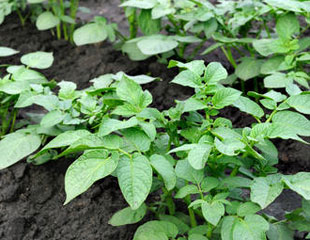
Growing Potatoes in May
When growing potatoes outside, keep an eye on the top growth, because if there is a frost, the top growth, called 'haulm', will need protection. This is illustrated and it can be damaged by frost. If the top growth gets caught in a frost, the Potato will survive, although it is likely to delay the flowering and harvest.
Potatoes like to be planted into a warm soil, so check the soil, not the calendar, if you want to get them off to a good start.
The same applies if you are growing potatoes in containers. Check the temperature of the compost as bags because if they have been stored outside the compost can be surprisingly cold. Cover the bed or tubs with fleece if there is frost. The early potatoes may need earthing up for the first time in late May/early June, which helps to improve the crop as it allows more potatoes to form as the season goes on; more about growing potatoes with tips and hints on how to get the best crop.
Herbs and Salad Crops
Herbs make a great addition to the veg plot, but not all herbs can be planted out just yet.
Plant outside Thyme, Rosemary, Parsley and Mint.
Sow the tender herbs, basil, coriander, dill, Thai basil, and tarragon in pots under glass ready to plant out later month.
Parsley can be slow to germinate, and may look as if it's doing nothing, but don't abandon the pot for several weeks. Herbs are so expensive to buy they are always top of my growing list. Growing herbs from seed or small plants and home grown seem to last a lot longer than the supermarket versions.
You can re cycle supermarket herbs. I keep pots of herbs purchased from the supermarket over the winter and put them in the greenhouse. They re grow and then get planted outside in the summer. And if growing from seed is not your thing, you can divide up cheap supermarket herbs Video advice how to make a cheap and easy herb garden.
This month is the right time to plant out lettuce and rocket, either as small plants or sow under a cloche.
As the lettuce appears, so will the slugs. Slugs love young lettuce and will munch through a crop overnight.
More information on protection and how to beat the slugs
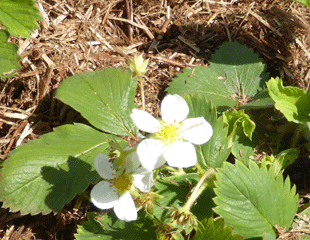
Avoid gluts by successive owing and planting
Even at this early stage in the growing season it is worth thinking about how to avoid gluts which is by "Successive sowing and planting" To have a regular supply of veg it is necessary to sow/or plant a regular supply of plants or seeds at regular intervals so that they are ready to harvest spaced by the of planting interval. Seeds sown together, will crop together, and so create a glut. A useful rule of thumb, (and easy to remember) is to plant or sow every fortnight for successive cropping.
Also in May check out emerging fruit on the strawberries before the birds do. Net and protect the plants from the birds to make sure you can enjoy the crop as the birds love strawberries. Place straw around to protect the fruit from dirt and rain splashes (which can cause mould). I like to keep strawberries covered with a cloche through the early growing months as the extra shelter aids an earlier crop.
These strawberries have been mulched with strulch a brand of mulch which I find very effective and easy to use. I use it on the strawberry plants and all around the garden as a good mulch. It is also very light and clean to handle.

